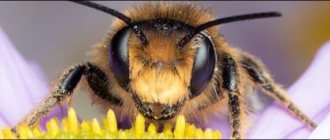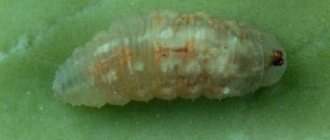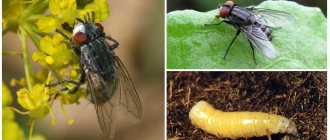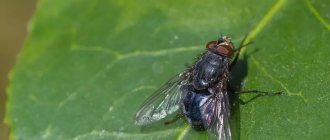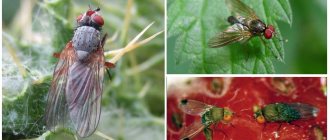Appearance and internal structure
At first glance, the body structure of a fly seems simple, but in fact, many institutes have been studying these insects for a long time. The body of a fly consists of three parts: head, thorax and abdomen. The lower part of the head has a yellow tint. The following organs are located on it:
- Eyes. In the fly they are quite large and consist of many small simple eyes that form a faceted network. The image obtained using facets has the appearance of a mosaic.
- Oral apparatus. Insects have powerful jaws and a proboscis. Food enters through the lobes of the upper and lower lips. A large number of tubules connect at the central point of the proboscis. In species that feed on blood, the structure of the oral apparatus contains sharp plates with which the insect pierces the skin of the prey.
- Mustache. This organ helps to navigate in space and smell. The antennae of females and males may differ.
The chest has three segments, the second segment being the most developed. On the chest there are 3 pairs of limbs, which consist of 5 segments. The legs of flies are equipped with developed muscles, claws and suckers. When the fly walks, the pads of its feet secrete a sticky liquid. The paws perform another function - they analyze the quality and taste of food.
The front pair of wings is well developed, has a membranous structure, the hind wings are deformed and form halteres. With the help of these appendages, the fly can hover in the air and maintain balance.
The cylindrical abdomen consists of 10 segments. The chitinous shell of flies tends to stretch when saturated and during pregnancy.
The most important internal organs are located in the abdomen. The reproductive system is represented by ducts, accessory glands, as well as eggs or testes, depending on the gender of the individual. External appendages differ from species to species.
Females lay clutches of eggs; their number per clutch can range from 70 to 150, depending on the species. In the family of corpse flies there are viviparous ones.
The digestive system is represented by the goiter, intestines, Malpighian vessels and excretory tubules. Food is digested before absorption; for this, the insect introduces a special digestive secretion into it.
The respiratory organs include a large number of tracheae, which are distributed throughout the body. Their opening to the outside is ensured by spiracles.
The brain is made up of many neurons. The circulatory system includes the heart, aorta, pterygoid muscle and dorsal vessel. Blood is colorless and transports nutrients.
Internal structure
Having studied the internal structure of a fly, an ordinary person will make a lot of discoveries for himself. Entomologists know very well how many internal organs and systems this insect has, what their tasks are and how they function.
Reproductive system
The internal reproductive organs are abdominal. The male has testes, the female has eggs. The reproductive system also includes accessory glands and ducts. The external appendages differ in shape among different species.
How many eggs the female lays at one time (70-150), depending on her species. Among blowflies (corpse flies) there are viviparous species.
The fertilized female finds a decomposing corpse and sits on it, touching the surface with her abdomen. After this, very mobile larvae instantly appear and quickly penetrate the tissue.
Digestive system
The abdomen contains most of the digestive organs: intestines, crop, excretory vessels. Inside, there is no digestive tract as such.
All food is digested externally with the help of a secretion secreted by the parasite. And into the expanded part of the esophagus, food arrives ready for absorption.
Other organs, systems
- brain and nervous system. Everything is very simplified. The brain coordinates the behavior of the insect, but the reflex arc is responsible for the reflexes. The brain is very small, but has thousands of neurons. It allows the buzzing parasites to perform amazing feats while flying.
- Circulatory system. It is equipped with an aorta, pterygoid muscle, and dorsal vessel. There is also a heart, but it is very simplified and has little functionality. The blood is colorless or has a yellowish tint. It transports nutrients throughout the body, but does not saturate the body with oxygen, and also does not contain red blood cells.
- Respiratory system. The body of the pest is dotted with numerous tracheae, which branch into small capillaries with a complex structure. Opens outwards with spiracles. They carry oxygen directly to various organs and tissues. Entomologists know how many spiracles there are on the body, thanks to which flies breathe. They report that there are up to 10 pairs of such body elements. Of these, 8 are located on the abdomen, and 2 on the chest.
How to protect yourself from gadfly larvae?
To avoid infection with gadfly larvae, you must follow simple rules:
- When traveling to southern countries where insects dangerous to humans live, you must take special insecticidal agents that repel flies (sprays, ointments, creams).
- Protective clothing and mosquito nets will help avoid contact with flies.
- Avoid contact with insects in nature and in other places where gadflies gather, for example, on a farm or in a village.
The larva of a gadfly can cause quite a few health problems if you do not consult a doctor promptly.
It is important to know that at the first symptoms, an examination and consultation with a doctor is necessary. Independent actions in this case are unacceptable. Human skin gadfly (Dermatobia hominis)
Human skin gadfly (Dermatobia hominis)
Gadfly happens:
Horse Gadfly
(Gasterophilus intestinalis) belongs to the most common species; its length is 13-16 mm. The color is yellow-brown, the chest is covered with protruding yellow or brownish hairs, the hairs on the abdomen are straw-yellow with an admixture of black. The wings are covered with small dark spots, and on the radial R1 vein, where the remaining R veins branch off, there is a bright black dot. Females have a long ovipositor that bends under the abdomen, and males have trochanters of the hind legs with a process.
Gadfly-hook (larva)
Gasterophilus intestinalis (larva)
(photo from www.diptera.info)
Ready to pupate, they come out along with the droppings and complete their metamorphosis on the ground. Sometimes the first stage larvae penetrate under the skin of a person and, moving in it, cause a “creeping disease” (poricozha). But they cannot fully develop on humans and soon die. Their growth rate depends on the ambient temperature and the condition of the animal itself. Worldwide distribution. Found anywhere there are horses or donkeys.
Life cycle
Gadflies lay eggs in the host's body or sometimes spread them in another way, for example, with an ordinary housefly.
The eggs are laid directly into the animal's skin, where the larvae hatch from the eggs: the animal's high body temperature causes the eggs to mature after contact with the body. Some species of botflies also live in the digestive tract, as skin irritation caused by the larva causes the animal to lick the area, whereby the larva enters the mouth and is swallowed.
Myiases can be caused by the penetration of a larva into the skin (or folds of skin) on a host animal.
Mature larvae fall out of the host and complete the stage of transformation into a pupa already on the ground.
Gadflies are a constant source of difficulty in equestrian sports for people caring for horses, as botflies lay eggs on the inside of horses' legs, on the tibia, on the knees, and sometimes on the throat or nose, depending on the type of botfly. These eggs, like small, yellow blobs, should be removed promptly during the insect breeding season (late summer and early fall) to avoid infecting the horse. When a horse rubs its nose against its legs, the eggs fall into the mouth, and from there into the intestines, where the larva grows and moves into the skin. When the larvae are ripe, the horse develops a tumor the size of a thumbnail; the tumor is not painful, but if it appears in the place where the saddle or bridle is put on, the horse will be unable to work until the wound caused by the appearance of young gadflies heals. In addition, the larva moving to the surface of the skin can cause sores in the mouth, abdominal ulcers and blockage of the intestinal (anal) opening, leading to colic.
Removing eggs
(which cling to the owner's hair) is complicated by the fact that the bone and tendons are located directly under the skin on the tibia: the eggs must be removed with a sharp knife (or blade) or rough sandpaper.
In addition, eggs must be detected in a timely manner before they are ripe. During their maturation, there is a possibility of human infection. Prevention
against larvae can be carried out by spraying with several types of preparations, including dichlorvos, ivermectin and chlorophos.
Scientific classification Kingdom
: Animals
Type
: Arthropods
Class
: Insects
Order
: Diptera
Suborder
: Short-whiskered
Infraorder
: Muscomorpha
Superfamily
: Gadflies
Family
: Gadfly (Gasterophilidae)
Many Russians have encountered these large flies that live in damp rural areas, but few people know that horseflies and gadflies can be deadly to humans.
Scientific discoveries and technical discoveries
While studying the body structure of flies, scientists became interested in some of their interesting features, which they were able to use in the design of technical devices:
- The unique structure of the fly's eyes, consisting of thousands of 6-sided miniature lenses, in which the image is obtained by summing it in several projections, contributed to the creation of a new camera that can immediately take 1300 pictures of an object (its lens consists of 1327 minilenses), this invention is used in modern computers that perform high-precision calculations;
- the structure of fly eyes is also used to create lattice solar panels that can generate large amounts of electricity;
- aviation engineers, based on the structure of fly wings and halteres, which allow them to become “masters of aerobatics” among all flying insects and birds, were able to create instruments for controlling flights in aircraft, as well as measuring the speed of rockets and airliners;
- By studying the hearing capabilities of flies and the structure of their eardrums, biologists came to the conclusion that the insect is able to determine the source of sound with high accuracy - this will help in improving and developing new designs for hearing aids and microphones;
- research by geneticists of one of the species of vinegar flies helped decipher its gene code and establish a greater degree of identity with the human one, which is planned to be used in the creation of drugs for kidney diseases and leukemia;
- Scientists' plans for the future are to use the physiological characteristics of flies to detect drugs and explosives.
Thus, the participation of mosquitoes and flies in the natural ecosystem brings more benefit than harm. And those who are afraid of being harmed by them can be advised to strictly observe the rules of hygiene in residential premises: regularly clean, throw out garbage on time, destroy incoming pests using available modern methods. This will help reduce the likelihood of harm from any flying insects.
Why is it so difficult to swat a fly?
Try swatting a fly and you will soon see that it is faster than you. Much faster.
But how do these tiny creatures with their tiny brains deceive us so easily? You've probably thought about this after chasing a fly around the house, waving your slipper and slamming it unsuccessfully over and over again.
How does she move so fast? Is she reading my mind? This issue was covered in the latest episode of our BBC World Service CrowdScience, which looked at the superpowers of small animals. The essence of the answer is that compared to us, flies perceive our world in slow motion.
To illustrate, look at a clock with a second hand. A person sees the arrow moving at a certain speed. For a turtle this speed is twice as high
For most fly species, each clock tick lasts about four times as long. The perceived speed of time varies between species
For a turtle, this speed is twice as high. For most fly species, each clock tick lasts about four times as long. The perceived speed of time varies among species.
This happens because animals perceive the world around them in the form of continuous video. In fact, they build this picture based on images coming from the eyes to the brain in the form of separate flashes, a certain number of times per second. In humans, approximately 60 such flashes occur per second, in turtles - 15, in flies - 250.
String theory
The eyes of flies have evolved to sense light through a set of tiny string-like structures arranged horizontally along the path of light through the eye.
These structures react mechanically to light, while vertebrates have elongated tube-like cells directed towards the light in which chemical compounds react to light. Roger is studying the structure of a fly's eye in his laboratory.
"It's more sensitive, in the sense that it can produce a large signal for the smallest amount of light, and it can respond faster than the rods and cones in the vertebrate eye," he explains.
There are several reasons for this increased sensitivity, but it was Hardy who discovered that they react to light mechanically, rather than chemically, like cones and rods. Mechanical response allows for faster creation of nerve signals.
Additionally, there is a limit to the speed at which nerve impulses can travel—and the short distance between the fly's eye and brain speeds up the process compared to large vertebrates. Some vertebrates have vision faster than ours. Apparently, the ability to fly correlates with the speed of vision, as does small size. This may be because small flying animals must be able to react quickly in flight to avoid approaching obstacles.
Slow claps
The fastest vision is found in species that catch flies in the air.
By studying the vision of the pied flycatcher, a small passerine bird that catches flies in flight, scientists from Uppsala University in Sweden found that it was able to detect the flashing of light at a rate of 146 times per second.
Birds were trained to associate a flashing light with a treat, and they successfully discriminated the flashing light at speeds of 146 times/sec. This is about twice as fast as humans can see, but not as fast as the average fly. This means that birds, like flies, perceive each tick of the clock slower than people. Flycatchers are pressured by evolution to perceive the passage of time as slowly as possible in order to stay ahead of their fast prey. Over the course of evolution, birds that perceive time more slowly can respond more quickly to prey, eat more, raise more chicks, and pass on speed vision to future generations. Flies that are caught by birds with fast vision will also develop a faster response to avoid being caught. This evolutionary arms race has been going on longer than the birds themselves have existed. Prey flies have been developing fast vision to avoid being caught by predatory flies ever since they learned to fly.
The next time you try and fail to swat a fly, don't get discouraged. Your clumsy and slow movement has met millions of years of natural selection, which has allowed the flies to perceive your attempts in slow motion. In general, for you and for the fly, time seems to pass relatively.
- fly
- fly swatter
- newspaper
- slippers
- neural signals
- vision
- cones
- sticks
Hubs:
Item Shape
The perception of the shape of an object by different insects is interesting. The specificity is that they may not perceive simple forms at all, which are not necessary for their viability. Bees and butterflies do not see objects of simple shapes, especially stationary ones, but they are attracted to everything that has complex flower shapes, especially if they move or sway. This explains, in particular, the fact that bees and wasps rarely sting a person standing motionless, and if they do, it is in the area of the lips when he is talking (moving his lips). Flies and some other insects do not perceive a person; they sit on him simply in search of food, which they look for by smell and see with sensors on their paws.
Modern scientific developments
Recently, compound eyes have been a subject of study and delight for scientists. After all, such organs of vision, due to their original structure, provide the basis for scientific inventions and research in the world of modern optics. The main advantages are a wide overview of the space, the development of artificial facets, used mainly in miniature, compact, secret surveillance systems.
It might be useful to read:
- Causes and treatment of uterine subinvolution after childbirth;
- Online test “What kind of cat are you? Test how much of a cat you are;
- We take an Igm immunoglobulin test; what kind of test is it?
- “For health you need cold and movement”;
- Peony officinalis Peony flowers in folk medicine;
- Headache and pressure on eyes - what to do? ;
- Healing properties, uses and contraindications of peony petals Peony flowers medicinal properties;
- Blood after constipation Frequent constipation; bloody stool;
Compound eyes - what's the point?
The fly's visual system includes two large eyes located at the edges of the head. Each of them has a complex structure and consists of many small hexagonal facets, hence the name of this type of vision as faceted.
In total, the fly eye has more than 3.5 thousand of these microscopic components in its structure. And each of them is capable of capturing only a tiny part of the overall image, transmitting information about the resulting mini-picture to the brain, which puts all the puzzles of this picture together.
More developed animals tend to concentrate their vision on a certain narrow area or on a specific object
For insects, it is important not so much to see a specific object as to quickly navigate in space and notice the approach of danger.
Number of eyes
As already mentioned, 2 large compound eyes are located on the sides of the fly's head. In females, the location of the organs of vision is somewhat expanded (separated by a wide forehead), while in males the eyes are slightly closer to each other.
But on the midline of the forehead, behind the compound compound eyes, there are 3 more regular (non-compound) eyes for additional vision. Most often, they come into play when it is necessary to examine an object close up, since a complex eye with perfect vision is not so necessary in this case. It turns out that flies have 5 eyes in total.
The brain of a fly is hardly larger than the hole in a sewing needle. But a fly, having such a brain, manages to process more than a hundred static images (frames) per second. As you know, the human limit is approximately 25 frames per second. And the fly found a simpler and more efficient way to process images. And this could not but interest researchers in the field of robotics. Flies were found to process 100 frames per second. And this allows them to detect an obstacle during flight within a few milliseconds (a millisecond is one thousandth of a second)
In particular, the researchers focused their attention on optical flows, which they called “optical field flows.” It appears that this optical field is processed only by the first layer of neurons
They process the “rough” source signal from each fly “pixel”. And they send the processed information to the next layer of neurons. And, according to the researchers, there are only 60 of these secondary neurons in each hemisphere of the fly brain. However, the fly brain manages to reduce or fragment the field of view into many sequential “motion vectors” that give the fly a vector of direction of movement and “instantaneous” speed. And what’s interesting is that the fly sees it all!
We, people (and not everyone), know what a vector and instantaneous speed are. And the fly, naturally, has no idea about these things. And such abilities of the fly’s brain to process a huge amount of information can only be envied. Why do we see only about 50 frames per second, and the fly 100? It's hard to say, but there are reasonable guesses on this matter. How does a fly fly? Almost “instantly”, with enormous acceleration. We could hardly withstand such an overload. But it is possible to create a robotic brain that is as fast as the brain of a fly in processing information flows.
To try to understand how a tiny fly brain can process such a huge amount of information, researchers in Munich have created a “flight simulator” for a fly. The fly could fly, but was kept on a leash. Electrodes recorded the response of the fly's brain cells. And researchers tried to understand what happens in the fly’s brain during flight.
The first results are obvious. Flies process images from their fixed eyes very differently than humans do. When a fly moves in space, “optical flux fields” are formed in its brain, which give the fly the direction of movement.
How would a person see it? For example, when moving forward, surrounding objects would instantly scatter to the sides. And objects in the field of view would appear larger than they actually are. And it would seem that nearby and distant objects move differently.
The speed and direction with which objects flash before the eyes of a fly generate typical patterns of motion vectors - field flows. Which, at the second stage of image processing, reach the so-called “lobula plate” - the center of vision of a higher level. In each hemisphere of the fly's brain there are only 60 nerve cells responsible for vision. Each of these nerve cells responds only to a signal with a certain intensity.
But for the analysis of optical flows, information coming from both eyes simultaneously is important. This connection is provided by special neurons called “VS cells”. They allow the fly to accurately assess its location in space and flight speed. It appears that the “VS cells” are responsible for sensing and responding to the torque applied to the fly during its flight maneuvers.
Robotics researchers are working to develop robots that can observe their environment using digital cameras, learn what they see, and respond appropriately to changes in the current situation. And communicate and interact with people effectively and safely.
For example, development is already underway on a small flying robot, the position and speed of which will be controlled using a computer system that imitates the vision of a fly.
Features of the visual abilities of flies
The vision of the common fly has many more interesting features:
- Flies distinguish primary colors and their shades perfectly, and they are also able to distinguish ultraviolet rays;
- they see absolutely nothing in the dark and therefore sleep at night;
- however, they perceive some colors from the entire palette a little differently, which is why they are conventionally considered color blind;
- the facet device of the eyes allows you to simultaneously fix everything above, below, left, right and in front and makes it possible to quickly respond to approaching danger;
- the eyes of a fly distinguish only small objects, for example, the approach of a hand, but do not perceive a large human figure or furniture in the room;
- in males, the compound eyes are located closer to each other compared to females, which have a wider forehead;
Interesting!
Visual acuity is also evidenced by the fact how many frames per second a fly sees. For comparison, exact figures: a person perceives only 16, and a fly perceives 250-300 frames per second, which helps it perfectly navigate at high speeds in flight.
What abilities does vision have?
It is worth considering the structure of the human eye. Cones and rods are components of photoreceptors, the so-called perception system. Thanks to them, you can distinguish colors and shades and perceive images. The difficulty in finding the maximum fps (framers per second) lies in the location of these receptors. In humans, the number of FPS in the periphery of the visual system is increased. This is a kind of adaptation of the body to the way of existence, which determines what the human eye sees.
The visual system is configured to see the whole picture. That's why if you show 1 frame per second for a while, the person will see the full image. However, it has been proven that sudden changes in fps are uncomfortable and difficult for the human eye to perceive. In the days of silent films, the number of frames was 16, but greedy theater owners deliberately increased it to 30, which negatively affected the viewing experience. The standard that is comfortable for vision is 24 fps. The visual system is unique: the perception of 60-100 frames per second can be comfortable. However, this is not the limit at all, since there are known cases where the FPS was 220.
Is this the limit?
In computer games, this figure has become significantly higher, making their images more believable.
Scientists are interested in answers to the questions, what is the maximum frame rate and what will happen if you increase fps, what is the point of this. Indeed, it would be more logical not to change anything, but computer game manufacturers were not satisfied with this decision. And every gamer can be convinced of this. The creators began to conduct experiments. The purpose of this was to find out how many frames are needed to make the visible picture on the monitor seem realistic. Although in standard cartoons, movies and videos the norm for this indicator is 24, the results of the experiments have helped the film industry and gaming companies move forward. This led to the emergence of a new format - IMAX and 3D, which are used in cinemas. And the main number of frames in racing, arcades, shooters and others has become 50, but may change due to Internet speed.
How does a fly see the world around it?
Large, convex eyes allow the fly to see everything around it, that is, the visual angle is 360 degrees. This is twice as wide as a human's. The insect's motionless eyes simultaneously look in all four directions. But the visual acuity of a fly is almost 100 times lower than that of a human!
Since each ommatidia is an independent cell, the picture turns out to be a mesh, consisting of thousands of individual small images that complement each other. Therefore, for a fly, the world is an assembled puzzle consisting of several thousand pieces, and a rather vague one at that. The insect sees more or less clearly at only a distance of 40 - 70 centimeters.
The fly is able to distinguish colors and even polarized light and ultraviolet invisible to the human eye. The fly's eye senses the slightest changes in the brightness of light. She is able to see the sun hidden by thick clouds. But in the dark, flies see poorly and lead a predominantly diurnal lifestyle.
Another interesting ability of a fly is its quick reaction to movement. A fly perceives a moving object 10 times faster than a human. It easily “calculates” the speed of an object. This ability is vital for determining the distance to the source of danger and is achieved by “transmitting” the image from one cell - the ommatidia - to another. Aviation engineers took advantage of this feature of the fly's vision and developed a device for calculating the speed of a flying aircraft, repeating the structure of its eye.
Thanks to such fast perception, flies live in a slower reality compared to us. A movement that lasts a second, from a human point of view, is perceived by a fly as a ten-second action. Surely people seem to them to be very slow creatures. The insect's brain works at the speed of a supercomputer, receiving an image, analyzing it and transmitting the appropriate commands to the body in thousandths of a second. Therefore, it is not always possible to swat a fly.
So, the correct answer to the question “How many eyes does an ordinary fly have?” the number will be five. The main ones are a paired organ in the fly, as in many living beings. Why nature created exactly three simple eyes remains a mystery.
Both flies and bees have five eyes.
Three simple eyes are located in the upper part of the head (one might say, on the crown), and two complex, or facet, eyes are located on the sides of the head. The compound eyes of flies, bees (as well as butterflies, dragonflies and some other insects) are the subject of enthusiastic study by scientists. The fact is that these organs of vision are arranged in a very interesting way. They are made up of thousands of individual hexagons, or, in scientific terms, facets. Each of the facets is a miniature peephole that gives an image of a separate part of the object. There are approximately 4,000 facets in the complex eyes of a housefly, 5,000 in a worker bee, 8,000 in a drone, up to 17,000 in a butterfly, and up to 30,000 in a dragonfly. It turns out that the eyes of insects send several thousand images of individual parts of an object to their brains, which, although they merge into the image of the object as a whole, still this object looks as if it were made of a mosaic.
Why are compound eyes needed?
It is believed that with their help insects orient themselves in flight. While simple eyes are designed to look at objects that are nearby. So, if a bee's compound eyes are removed or covered, it behaves as if it were blind. If the simple eyes are sealed, then it seems that the insect has a slow reaction.
1,2
–
Compound (compound) eyes of a bee or fly 3
–
three simple eyes of a bee or fly
Five eyes allow insects to cover 360 degrees
, that is, to see everything that happens in front, on both sides and behind. Maybe that’s why it’s so difficult to get close to a fly unnoticed. And if you consider that compound eyes see a moving object much better than a stationary one, then one can only wonder how a person sometimes manages to swat a fly with a newspaper!
The ability of insects with compound eyes to detect even the slightest movement is reflected in the following example: if bees and flies sit down with people to watch a movie, it will seem to them that bipedal viewers are looking at one frame for a long time before moving on to look at the next. In order for insects to watch a movie (and not individual frames, like a photo), the projector film needs to be spun 10 times faster.
Should we envy the eyes of insects? Probably not. For example, the eyes of a fly see a lot, but are not capable of looking closely. That's why they discover food (a drop of jam, for example) by crawling across the table and literally bumping into it. And bees, due to the peculiarities of their vision, do not distinguish the color red - for them it is black, gray or blue.
Number of eyes in a fly
Focusing on our own perception of the world around us, most of us, when answering the question: how many eyes does an ordinary fly have, will say without hesitation: two. But in fact, these dipterous insects have more visual organs than people, animals and birds.
When examining an insect with the naked eye, a person can only see 2 large oval eyes on the sides of the fly's head. Meanwhile, she has 3 more small, barely noticeable organs of vision located in the frontal part.
The large eyes are called the main eyes; they have a complex structure that provides the insect with a panoramic vision of the world. Small eyes are auxiliary, and with them the fly not only sees, but rather “focuses” for a better look at the fragments.
The sex of the insect can be determined by the distance between the main eyes. In females they are more spaced apart than in males. Because of this, in males the frontal part is almost invisible.
⇡ In cinema halls
It all started with silent cinema, which used film with 16 frames per second. When showing excerpts from pre-war films, you probably noticed an unnaturally high speed of what was happening on the screen - this is a consequence of the corresponding frame rate. Then, with the advent of sound in films, the number of frames was increased to 24 to accommodate the audio track (otherwise the sound was too distorted), this value remains relevant to this day. However, to be precise, cinemas show films not with 24, but with 48 frames per second. This is due to the operation of one of the parts of the projector, the shutter - a mechanical device for periodically blocking the light flux as the film moves in the frame window. That is, roughly speaking, every second frame is simply “empty”, and flickering is almost imperceptible.
Nevertheless, in cinema there has been talk for decades about the need to switch from the usual standard of 24 frames per second. But this was hampered by a number of problems, mainly related to technological difficulties. However, in recent years, when films began to be increasingly shot and shown in cinemas using digital equipment, the task in this regard has become significantly easier.
This negatively affects the authenticity of the film, often negating some directorial and camera techniques. But all this does not in the least cancel out all the positive properties that video with a high frame rate has. This is both amazing smoothness of the image and naturalness of the picture - just like in real life, which creates an excellent effect of presence and belief in what is happening. And finally, a larger number of frames eliminates flicker (especially noticeable at the edges of the screen), reducing eye fatigue.
James Cameron, the main film innovator on our planet, who made the whole world fall in love with 3D, seriously promised to make another revolution in the industry. His next projects “Avatar-2” and “Avatar-3” will be filmed in 60 frames per second and will clearly demonstrate to humanity all the advantages of such technology.
Flicker frequency
Scientists began to conduct research to explain the ability of flies to react to sudden danger. Their results were convincing. The secret of such a quick reaction to what is happening lies in the frequency of flicker perceived by the organ of vision. The critical, that is, the maximum possible flicker frequency for a person is 60 frames per second or 3600 frames per minute. At this frequency, people see images in real time. But this time is very different for different types of creatures on the planet.
After a series of experiments, scientists found out how many frames per second a fly sees. Unlike a person, she is capable of perceiving up to 250 frames. This means that fast movements perceived by human vision appear very slow to a fly. Therefore, she manages to escape from danger. Other animals also have their own individual fps flicker rates:
- leatherback turtle – 15;
- hammerhead shark – 60;
- dog – 80;
- gopher – 120;
- predator flies – 400.
Thanks to the expanded spectrum of perception of the surrounding world, a fly sees more colors than a human and even distinguishes ultraviolet light. The world through the eyes of a fly is more colorful and vibrant. The human ability to distinguish only seven colors is significantly inferior to insects. They can see more subtle shades of colors and iridescence. Also, many species of animals have the ability to see, hear and feel much more than humans.
Eyes of a fly
When people talk about the too short life of this or that animal, we should not forget about the relativity of the passage of time. Each species lives its life in its own time dimension. And the higher the flickering frequency, the more events occur in the world of this creature. During its short existence in our world, a fly has a full life, during which it manages to complete all the necessary development cycles.
